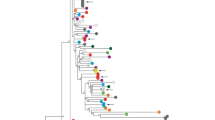Abstract
Retroelements are ubiquitous features of eukaryotic genomes, often accounting for a substantial fraction of their total DNA content. One major group of retroelements, which includes the gypsy and copia-like elements, is distinguished by the presence of long terminal repeats (LTRs). We have identified and partially characterized a sequence from banana (Musa acuminata cv. Grand Nain) which shows significant homology to gypsy-like LTR retroelements from other species. The element, named monkey, shows a high degree of homology to the reverse transcriptase, RNase H and integrase genes of retroelements from plants, fungi and yeast. However, several stop codons are present in the major ORF of this element, suggesting that this copy of monkey, if functional, is non-autonomous. Southern analysis indicated that monkey is present in both the A and B genomes of Musa, and that it is found in 200–500 copies per haploid genome in cv. Grand Nain. Chromosomal localization by fluorescent in-situ hybridization indicates that copies of monkey are concentrated in the nucleolar organizer regions and colocalize with rRNA genes. Other copies of monkey appear to be dispersed throughout the genome.
Similar content being viewed by others
Author information
Authors and Affiliations
Additional information
Received: 30 August 1999 / Accepted: 7 April 2000
Rights and permissions
About this article
Cite this article
Balint-Kurti, P., Clendennen, S., Doleželová, M. et al. Identification and chromosomal localization of the monkey retrotransposon in Musa sp.. Mol Gen Genet 263, 908–915 (2000). https://doi.org/10.1007/s004380000265
Issue Date:
DOI: https://doi.org/10.1007/s004380000265




